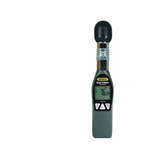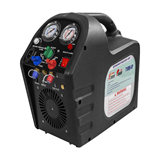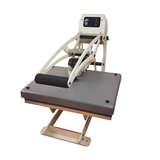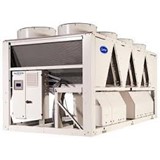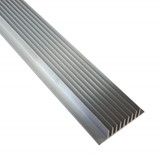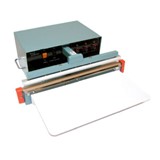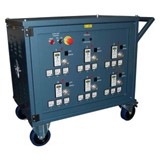Sustainable Energy Authority Victoria
Lafarge Plasterboard is part of the global Lafarge Group, a leading global building materials supplier employing over 77,000 people and operating in over 75 countries.
Lafarge Plasterboard’s manufacturing facilities are located in Matraville (Sydney) and Altona (Melbourne). The Altona site employs 60 people, and produces approximately 15 -18 million square meters of plasterboard per annum.
An energy intensive step in the process of manufacturing plasterboard is in the drying of the product. This essentially involves the use of gas fired heating to produce large volumes of heated air, which passes over the plasterboard to drive the rapid evaporation of water contained in the freshly formed plasterboard.
Lafarge Plasterboard is currently considering a heat recovery upgrade for the drying process, primarily driven by the need to reduce energy costs and increased productivity.
Project Description
Current key process steps in the manufacturing of plasterboard include: plaster preparation, forming into cardboard-lined sheets, rolling/pressing, drying and packaging ready for storage and distribution.
The drying process consists of a two-stage process, in Stage 1 (“Zone 1”, counter current air flow) the plasterboard is heated to 100 deg C, followed by 95 deg C in Stage 2 (“Zone 2”, co-current air flow).
The plaster drying process must be carefully controlled to ensure uniform standard of product quality. The drying process operates at 100% capacity for most of the product lines produced at the Lafarge Plasterboard Altona site.
Lafarge Plasterboard plan to implement an innovative heat recovery technology to recover both heat and water from exhaust gases that currently vent to the outside air. Implementation of heat recovery technology will allow the capture of energy from exhaust gases for re-use in the drying process, condensation and collection of water from the humid exhaust air and improved productivity with faster drying of the plasterboard.
In particular, this project recovers heat from the exhaust gas from the first stage of the plaster board dryer to preheat the intake air required for the second stage of the plasterboard dryer using a heat exchanger.
The supply air is drawn from outside the building, as the temperature here is lower then inside. The air passes through a filter and FD centrifugal fan, before entering the bottom side of the heat exchanger. The air will travel along a 'U' path, counter-current to the exhaust stream, departing the same side at the top.
The hot supply air is then ducted to the required zones; zone 1 combustion air, zone 2 combustion air and zone 2 infiltration air. Dampers will be installed on all these outlets for balancing the flows.
The existing zone 1 flue contains a damper which is fully open. With implementation of this project, this damper would be closed, redirecting the zone 1 exhaust through the proposed plate heat exchanger. The exhaust will enter the top of the exchanger at approximately 172 deg C, traveling along the 'I' path, leaving from the base at approximately 75 deg C. Since the stream is being cooled below its dew point, this configuration allows any water condensed in the exchanger to flow co-current with the exhaust stream, as well as a greater ease of cleaning.
Cleaning will be performed by a spray supplied by mains water, set up as a deluge system at a flow of 1.5m3/min. As an indicator of particulate build-up, a differential pressure sensor indicates to the operator when the deluge system is required.
Additionally, a water collection system will be provided to handle the significant volumes of water (4 to 5 tonnes per hour) which will be generated when cooling the exhaust gas from the first stage of the plasterboard dryer through this process. The collected water will be treated if necessary and reused in the process. The initial feasibility study did not include consideration of the water recover potential. This will be considered as part of future works and will influence the type of heat exchanger selected.
The water recovered from the heat exchanger is collected in a condensate recovery tank. The base of the tank is to be sloped, so as to let any particulate matter to settle out, allowing it to be removed from the base of the tank. The tank would have a level sensor to periodically pump water from the tank, supplying it back to the process water storage tank.
The development and capital implementation cost for this project has been estimated at $300,000 with a payback time of under four years.
Sustainability Victoria has been closely involved with this project, initiating a detailed design of the mechanical infrastructure and heat exchange technology for installation, identifying new equipment needed and facilitating the installation of the machinery to a tight target window of opportunity, coinciding with a full plant shutdown. After commissioning and testing under controlled conditions Sustainability Victoria will conduct a full report and analysis of the Lafarge Plasterboard heat recovery project.
The project commenced in April 2005 and is expected to be commissioned and in operation by March 2006.
Expected Outcomes
When complete, the Lafarge Plasterboard heat recovery project is estimated to save a 15% reduction in the energy input required for drying, which equates to 15,000 GJ per annum (or $80,000 per annum) saving in natural gas consumption.
The dryer operates at 100% capacity for many of the product lines produced at this site, thus limiting further production growth. A 15% reduction in dryer load will allow more product to be passed through. The percentage increase is unknown and is expected to be dependent on product type. A 15% reduction in natural gas will not necessary translate to a 15% productivity improvement on all grades of product.
There is an expected increase in productivity, mainly associated with more efficient drying. At this stage it is expected that productivity may increase by approximately 10%, however further work needs to be performed to understand the likely benefit.
The greenhouse pollution reduction is expected to be 1,600 tonnes per annum, which is equivalent to removing 370 cars from Victorian roads each year.
This project will also recover and recycle an estimated 13.2 million litres of water per annum for a cost saving of approximately $11,000 per annum.


